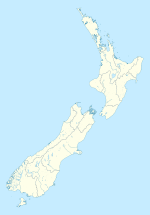Alexandra, New Zealand
| Alexandra | ||
|---|---|---|
| Urban Area | Population | 4,827 (2006) |
| Territorial Authority |
Name | Central Otago District Council |
| Population | 16,950 (2006 est.) | |
| Extent |
Includes the towns of Alexandra | |
| Regional Council |
Name | Otago |
Alexandra (Maori: Areketanara) is a town in the Central Otago district of the Otago region of New Zealand. It is located on the banks of the Clutha River (at the confluence of the Manuherikia River), on State Highway 8, 188 km by road from Dunedin and 33 km south of Cromwell.
At the time of the 2006 census, the permanent population was 4,827, an increase of 423 since 2001. 23.1 per cent of the population (higher than the national average) was aged over 65.[1]
History
The town was founded during the Central Otago goldrush in the 1860s, and was named after Alexandra of Denmark. It was known to miners of the day by several names: the "Lower Township", the "Junction Township", and "Manuherikia". (The "Upper Township" was Dunstan, now Clyde.)
Many orchards were destroyed in the 1980s as a result of construction, 10 km upriver, of the Clyde High Dam, which is the country's third largest hydroelectric power station.
Geography

Alexandra is the service centre for a significant stone-fruit industry, which is celebrated by a blossom festival in the town each spring. Grape production is another major industry in the Central Otago Wine Region. Alexandra has the world's southernmost vineyard, Black Ridge.
The town is a popular holiday destination - during the holiday season the Otago Volts cricket team play many of their fixtures at Alexandra's Molyneux Park rather than at their home base, Dunedin's Carisbrook ground. Because of competing venues, this may not last much longer.
Alexandra is perhaps best known for its annual event, the Alexandra Blossom Festival. The Alexandra Blossom Festival celebrates the advent of Spring in the Central Otago District as evidenced by the blooming of the fruit trees. In 2006 Alexandra celebrated its 50th Blossom Festival, which was held from 15 September to 1 October.
The Alexandra Aerodrome is Alexandra's only airport. SPANZ, NAC and Mount Cook Airlines were main users of the airport till the 1980s. It is home to the Central Otago Flying Club, and gliding. It is reasonably quiet, and commercial passenger flights are no longer scheduled; Queenstown International Airport is the nearest facility for those.
Climate
Alexandra experiences a very dry oceanic climate (Köppen climate classification Cfb), so dry in fact, that it barely escapes being classified as a semi-arid climate (Köppen climate classification BSk). The district is one of the farthest from a coastline in New Zealand and experiences cold winters and warm summers relative to the rest of the country. Temperatures regularly drop below zero in winter and can rise above thirty degrees Celsius in the summer months.
| Climate data for Alexandra | |||||||||||||
|---|---|---|---|---|---|---|---|---|---|---|---|---|---|
| Month | Jan | Feb | Mar | Apr | May | Jun | Jul | Aug | Sep | Oct | Nov | Dec | Year |
| Mean daily maximum °C (°F) | 23.5 (74.3) |
23.8 (74.8) |
21.5 (70.7) |
17.5 (63.5) |
12.4 (54.3) |
7.5 (45.5) |
7.9 (46.2) |
11.4 (52.5) |
15 (59) |
17.5 (63.5) |
20.2 (68.4) |
22.1 (71.8) |
16.7 (62.1) |
| Mean daily minimum °C (°F) | 10.6 (51.1) |
10.5 (50.9) |
8.7 (47.7) |
5.1 (41.2) |
1.5 (34.7) |
−1.7 (28.9) |
−1.8 (28.8) |
−0.4 (31.3) |
2.9 (37.2) |
5.5 (41.9) |
7.6 (45.7) |
9.9 (49.8) |
4.9 (40.8) |
| Average precipitation mm (inches) | 29 (1.1) |
22 (0.9) |
40 (1.6) |
34 (1.3) |
35 (1.4) |
26 (1.0) |
23 (0.9) |
24 (0.9) |
27 (1.1) |
41 (1.6) |
26 (1.0) |
43 (1.7) |
360 (14.2) |
| Source: NIWA Climate Data[2] | |||||||||||||
Radio stations
Independently owned Blue Skies FM was established in 2001 as a radio station to serve the local community, but went off the air at the end of September 2008. Its frequency was taken by The Breeze.[3]
Alexandra also has its own local More FM station with the studios being located in Alexandra. Previously this station was known as Radio Central. Central Otago's More FM broadcasts into Roxburgh, Clyde and Cromwell. Wanaka also has More FM but this is a relay of the Queenstown More FM station (formerly known as Resort Radio).
Schools
Alexandra has three primary schools (Alexandra Primary School, Terrace Primary, and St Gerards). There is also one high school (Dunstan High School).
Mayors
This is a list of mayors of the former Alexandra Borough. Many streets in Alexandra are named after former mayors.
- Robert Finlay 1867-1870 and 1886–1889
- John Chapple 1871-1872
- William Beresford 1872-1873
- James Samson 1873-1877
- James Rivers 1877-1879 and 1894–1896
- George McDonald 1882-1884
- JE Thompson 1884-1886
- William Theyers 1890-1893 and 1895–1896
- J Simmonds 1893-1984 and 1896–1897
- James Kelman 1898-1899 and 1901–1903
- Henry Symes 1900-1901
- George Spencer 1903-1906
- Henry Schaumann 1906-1910
- J Gregg 1910-1911
- Edward Marslin 1911-1915
- Archibald Ashworth 1915-1917
- William Black 1917-1927
- William Bringans 1927-1940
- Archibald McKellar 1940-1947
- Bert Fox 1947-1953
- George Campbell 1953-1959
- Keith Blackmore 1959-1980
- Ross Close 1980-1986
- Russell Poole 1986-1989
See also
References
- Reed, A.W. (2002) The Reed dictionary of New Zealand place names. Auckland: Reed Books. ISBN 0-790-00761-4.
- ^ Quickstats about Alexandra
- ^ "Climate Data". NIWA. Retrieved November 2, 2007.
- ^ "Central community radio going off air". The Southland Times. 25 September 2008. Archived from the original on 2009-04-25.

